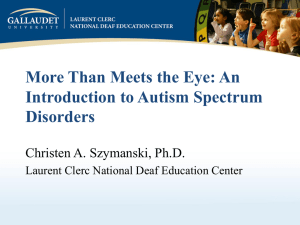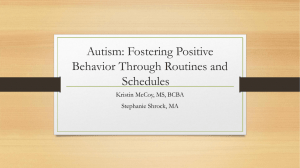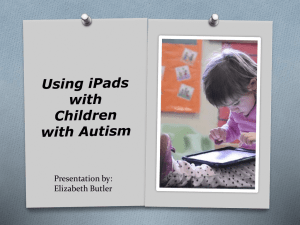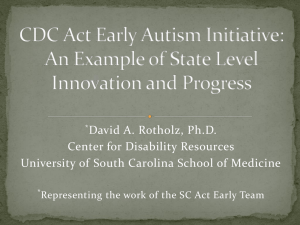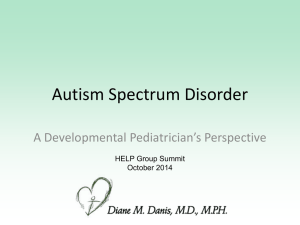Grandparents
advertisement
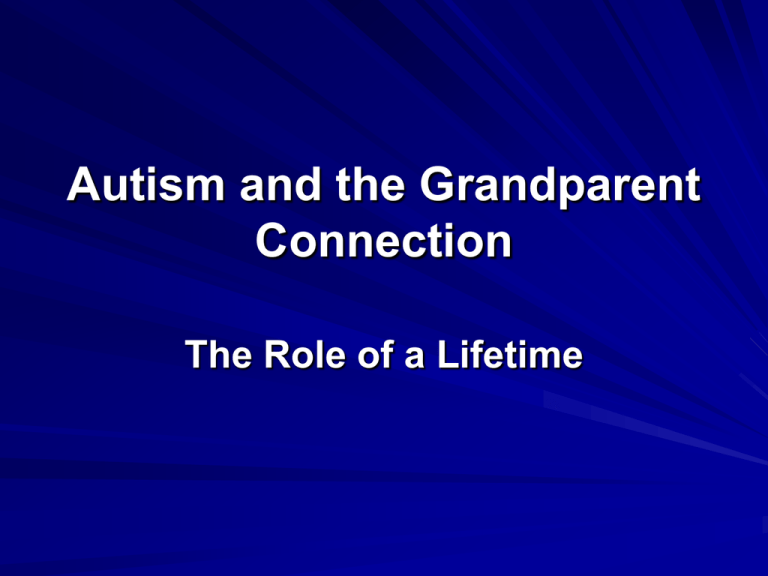
Autism and the Grandparent Connection The Role of a Lifetime Participants will: • Understand why grandparents play a significant role in the health and well being of the family of a child with autism • Understand practical ways that help • Identify some unhelpful responses • Be inspired and motivated to be the best you can be for your family E+R=O Event + Response = Outcome What are the EVENTS? Treatment decisions Family response Autism Diagnosis Waiting lists Behaviour School Decisions The only thing we can control… Event + Response = Outcome We can choose: Our thoughts Our behaviour Our dreams and images You must take personal responsibility . You cannot change the circumstances, the seasons, or the wind, but you can change yourself. Jim Rohn The potential you hold is life changing The Role of Grandparents: Roots to a child - a past and a future Nurture emotional health and well being in children with autism and their siblings Role model Physical presence The Solution… Find the Gift Maintain Optimism Build relationships Build your knowledge, credibility and skills “Grandparents can be role models about areas that may not be significant to young children directly but that can teach them about patience and courage when we are ill, or handicapped by problems of aging. Our attitudes toward retirement, marriage, recreation, even our feelings about death and dying may make much more of an impression than we realize. Eda LeShan What Does NOT Help? Questioning the diagnosis and insisting on getting a second opinion Ignoring attempts to explain the diagnosis and behaviour Dismissing the explanation provided by parents or doctors Blame Insisting on certain treatments, therapy or parenting methods What Does NOT Help? Information overload Concentrating your attention on the grandchild that does not have autism Emotional distance Overstepping boundaries Playing non-interference: “We do not want to meddle.” “BEING THERE” Affirm and love your adult child Listening to what is said and what is not said Accepting your grandchild “as is” Active Listening Keep the disability in perspective Be positive and hopeful Adhere to the limits and schedules established by your children “Doing” Provide your children with respite opportunities Play with your grandchildren Spend time with the siblings of the exceptional child Encourage your grandchild’s independence Read with your grandchild Share special Interests What attitude are you modeling? Is your grandchild learning anger? Hostility? Resentment? Fear? Blame? OR Is your grandchild learning hope? Persistence? Faith? Optimism? Collaboration? “If we make our goal to live a life of compassion and unconditional love, then the world will indeed become a garden where all kinds of flowers can bloom and grow.” Elizabeth Kubler-Ross Thriving Day by Day Reduce the amount of talking Reframe questions into statements The gift of Rituals Pictures, lists and diagrams are far more meaningful to most people with autism than are words Small but MIGHTY Tools! List the sequential steps of the task, providing visual cues to each step Visual schedules: pictures, written Clear beginning and ending to tasks Clear visual rules and regulations Lists, written sequences, step by step Small but MIGHTY Tools! Keep instruction systematic and direct Support what you say with a picture or written word Offer choices visually (only a few) Stop talking so much! Time Timer Processing Problems Executive Dysfunction Language Problems Mind Blindedness Sensory Problems Imitation Deficits Weak Central Coherence Surviving Meltdowns and Tantrums Is it any wonder that our children with autism OVER REACT? Behaviour is Communication I need your attention. I need something tangible. I need to change something. I need to escape or avoid something. I need to self regulate. Weathering the Storm 1. Stay completely calm. 2. Nix any notion that the child is a brat. 3. No discussion. 4. Wait. Breathe deeply. 5. Remind yourself that your own competence is not in question. 6. Calmly and safely remove him from the environment. Self Regulation and Self Management Teach HOW and WHEN to use: Stay Put box Safe Place/safe person Teach relaxation and belly breathing Yoga The Five Point Scale MODEL SELF CONTROL DO NOT Take Away Visual Support!! Helps to clarify expectations Provides ongoing organization and structure Decreases processing time Decreases reliance on adult prompts and cues Reduces anxiety Through it all, REMEMBER… What are we working towards? Autonomy Every task, every skill needs to be taught so that the student will complete it as independently as possible. What happens when we… Fail to fade prompts Rescue individuals from struggle Play helicopter parent Avoid personal responsibility Autism + Optimism, Joy, Hope __________________________________ Self Esteem A rich journey Putting it in Perspective… Child to Mom in response to whether to disclose his autism diagnosis: “ You know mom, I am so much MORE than my autism.” The potential you hold is life changing I wish you joy on the journey! Autism Aspirations Facebook Newsletter www.autismaspirations.com



